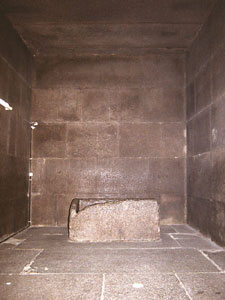The room near the top of the Great Pyramid is known as the King’s Chamber. Near the top of the Grand Gallery, three pink granite monoliths (which are still in place) form the door to the King’s Chamber. The modern entrance is located at the upper end of the south wall of the Grand Gallery.
The King’s Chamber measures 10.45 meters by 5.20 meters, is 5.80 meters high, and is made entirely of pink granite. It had to be built to resist an enormous amount of pressure from the masonry above. It is a great feat of architecture, as its flat roof (composed of nine huge granite blocks) supports over four hundred tons of masonry. In order to achieve this, the builders constructed five relieving chambers. In the four thousand years since their creation, only one small crack has developed in the ceiling slabs near the south wall.
The relief chambers of the King’s Chamber are only a few feet high. The sides are constructed from limestone and granite, and the ceilings from roughly cut blocks of pink granite. The higher chambers have saddle shaped ceilings to help bear the weight. The chambers were never meant to be seen, and so the builders left marks which have been preserved. Petrie claimed to have discovered a cattle census of the seventeenth year of Khufu’s reign. There is also quite a quantity of graffiti, left by more modern visitors, including; Nathanial Davison (an eighteenth century diplomat), Lord Nelson, Duke Wellington, Lady Ann Arbuthnot, and Patrick Campbell (Scottish diplomat and amateur archaeologist).
Within the chamber lies a red granite sarcophagus. It is very large (with an estimated weight of about 3.75 tons), so it was probably placed in the chamber during construction. It follows the form of early dynastic sarcophagi (a flat-sided box with a groove on the inside to support the lid with one end left open to allow the lid to slide into place, and three pins to seal the lid when it was in place). However, the sides of the coffer are not well finished. There are clear saw marks on the outside, and on the north-west corner the saw appears to have cut too deep on more than one occasion.

There are also the remains of a number of drill holes which the masons tried to smooth over, but could not fully remove.
The cover of the sarcophagus is missing, as is the king’s mummy. Some have suggested that it was a substitute sarcophagus, hastily prepared when the original was damaged, but there is no evidence to support this, and it doesn’t explain why it is unfinished. It is by no means clear that the King’s chamber was actually intended for a burial. If it was, it was the first and only time that a burial chamber was placed above the entrance.
Diodorus Siculus referred to ancient legends which claimed that Khufu was not buried in his pyramid. In contrast, Medieval Arab historians refer to a mummy-shaped coffin which held the king’s body. However, the sarcophagus is not mummiform, the king’s remains are no longer there (if they ever were), and it must be remembered that they visited the pyramids over three thousand years after Khufu’s death. More recently, Kozinski (a Polish architect) claimed that the crack in the chamber appeared before the pyramid was finished, leading to the construction of a new burial chamber which has yet to be found.
There are two “air shafts”, similar to those in the Queen’s Chamber, at heights of seventy-one and fifty-three meters. At the moment, there is a ventilation fan fitted into the southern shaft to regulate the moisture produced by visitors.
Copyright J Hill 2010